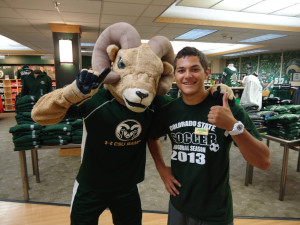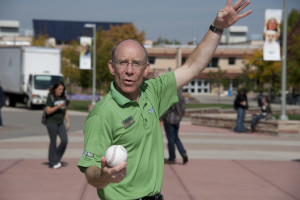CSU’s on-campus bookstore is one of the most efficiently run university bookstores in the state. We sat down with Director John Parry to see how he manages, runs and maintains an on-campus bookstore of this size.
What is the most rewarding part of being bookstore director?
The part that I find most rewarding at CSU would be the opportunity to work with so many different groups of people: the students, faculty, staff, alumni, athletics. It’s a broad, diverse group of individuals that I get to work with.
What is the hardest part of running an on-campus university bookstore?
The fact that you’re dealing with so many different constituents. It really is a challenge because the needs of the different groups we deal with are different. Students are very different than faculty and staff, who are very different than alumni.
The other difficult thing is that a large percentage of our main customer base rotates all the time. We have 25 percent to 30 percent new customers every year with just students because so many graduate and so many come in.
 What sort of techniques do you use to ensure the success of the store?
What sort of techniques do you use to ensure the success of the store?
Having experienced individuals that have a good understanding of what the visions and goals of the university are is vital.
What types of skills and input do your
student staff bring to the store? How do you apply this input?
It depends on the department. In our textbook area the students have a lot of responsibility in what they do, like communicating to vendors, but they don’t have as much responsibility for actually making ordering decisions or communicating with faculty on campus.
In our merchandise area, the students sit in on buys. They have input on styles, colors, graphic designs and stuff they think other students would be interested in. We also have a relationship with the design and merchandising department on campus, where we get input on some of what we bring in.
As far as running the store, we have student managers who have responsibilities as managers in the store. They have a key and a code and they run the stores on weekends to help them gain the experience they need moving forward in their lives.
We entrust our students with a great deal of responsibility.
How do you go through the trend prediction process for the apparel?
We rely a lot upon the vendors we work with. We have total control over colors we bring in and the graphics. We also have a lot of ideas presented to us from the athletics department through CSU’s uniform contract with Under Armour.
It’s a big combination that we want to make sure we are consistent on. There are a few looks and logos that we try to never be out of — Colorado State University, the ram head. Those are the ways that people identify CSU.
Revenue made by the bookstore is returned back to campus. What do those funds go towards?
University bookstores are set up in a couple of different ways.
There are a number of them that are co-ops, so they’re associated with the institution that they serve but they’re a stand-alone entity. There’s an agreement between the store and university on exactly what the store will provide to the university, and then anyone that belongs to the co-op can get a rebate. Again, there’s a number of different practices with co-ops.
There are also universities that lease out their bookstores to a third party. They come in and they run the stores. The biggest lease operators are Barnes and Noble and Follett.

CSU is an institutionally owned store. We are owned and operated by CSU. We have to generate all of our own revenues, as we don’t receive any student fees or state dollars. All of our operating revenues have to be generated by the bookstore. Anything that is left over, we give most of it to the Lory Student Center.
There is an amount of money that we give back to campus and we pay for some of the resources that we utilize: police, human resources, AP, but the majority of it goes to the student center. We pay over $800,000 in rent. There’s an additional amount — last year it was about 1.4 million dollars — that we return back to the LSC. Those moneys go into the pool that the student center uses for any sort of programs that happen here.
When you look at all of the money that we return back to CSU, the number is well over $2 million annually.
Are there any commonly asked questions that you’d like to address?
The biggest one in my mind is the interaction that we have on the textbook side of things. We’re not the ones who make decisions on what book is to be used in a class. That information is provided by instructors.
We go out and try and find as many of those books we can at the lowest price possible. Students are our best source of buying used books. We have a high number of used books and a great number of programs to help keep prices as low as possible.